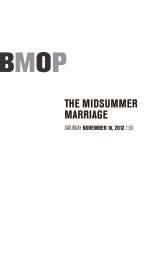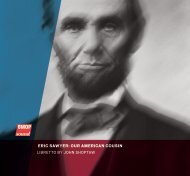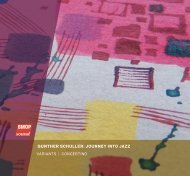Download the album booklet - Boston Modern Orchestra Project
Download the album booklet - Boston Modern Orchestra Project
Download the album booklet - Boston Modern Orchestra Project
You also want an ePaper? Increase the reach of your titles
YUMPU automatically turns print PDFs into web optimized ePapers that Google loves.
this case <strong>the</strong> notation itself affects <strong>the</strong> resulting performance, making it of interest to <strong>the</strong><br />
listener as well.<br />
Frame notation produces a kind of “controlled improvisation.” For a given instrumental<br />
part in <strong>the</strong> score, notes are placed within a box or frame along with varying degrees of specific<br />
instruction as to how material within <strong>the</strong> frame is to be played and how often it is to<br />
be repeated, if at all. <strong>the</strong> result is often a “cloud” of notes or more complex sound events<br />
that express a particular sonority, especially when several of <strong>the</strong>se frames coincide.<br />
<strong>the</strong> initial reaction of someone unfamiliar with this technique is that it must result in<br />
chaos. In fact, this does not happen, since pitch content within <strong>the</strong> frames is usually<br />
strictly controlled. on <strong>the</strong> one hand, it can produce random effects such as <strong>the</strong> “stochastic”<br />
passages in <strong>the</strong> music of Iannis Xenakis. on <strong>the</strong> o<strong>the</strong>r, it is related to jazz improvisation<br />
where scale content, chord progressions, and centonization formulas strictly control<br />
<strong>the</strong> performer’s freedom. but most interesting, like quotation and collage, frame notation<br />
is not an invention of <strong>the</strong> twentieth century; it has historical precedents as well.<br />
one of <strong>the</strong> techniques of <strong>the</strong> baroque era was to write a progression of chords and, in<br />
effect, allow <strong>the</strong> performer to play any notes of <strong>the</strong>se chords in any order <strong>the</strong>y wished—<br />
but controlled by a strict set of performance conventions. one example is <strong>the</strong> “thorough<br />
bass.” often <strong>the</strong> harpsichord would be given no more than a bass line and numbers under<br />
<strong>the</strong> notes—a code to indicate what notes could be improvised above <strong>the</strong> bass notes. and<br />
many times a composer would simply write a chord progression for a solo part and expect<br />
<strong>the</strong> performer, again, to improvise from <strong>the</strong> chords given. such is <strong>the</strong> case, for example, in<br />
<strong>the</strong> famous bach Chaconne. most listeners don’t realize that <strong>the</strong> original manuscript indicates<br />
that much of <strong>the</strong> music can be performed differently than we have come to expect<br />
from modern performances; bach gave <strong>the</strong> chords and left <strong>the</strong> performer to choose precisely<br />
how <strong>the</strong>y should be arpeggiated.<br />
elliott schwartz has always been on <strong>the</strong> edge of challenging our notions of <strong>the</strong> origin<br />
and ultimate “propriety” of music’s sources, bidding us to re-examine our perception of<br />
objects and ideas, both obvious and subtle, in our daily experience.<br />
I will not attempt to give any sort of listening guide to each work here, but will instead pick<br />
out one or two distinctive features of each work that might give <strong>the</strong> listener a vantage<br />
point from which each might be explored with repeated listenings. It is best here, as with<br />
most music, to simply indicate one of <strong>the</strong> several available ways “in” to each piece, recalling<br />
that <strong>the</strong> above comments about collage and <strong>the</strong> effects of frame notation apply to all<br />
of <strong>the</strong>se works.<br />
[1] Chamber Concerto I was composed in 1976 and premiered at <strong>the</strong> Chamber music<br />
Conference of <strong>the</strong> east with soloist bertram turetzky, double bass. <strong>the</strong> work is scored for<br />
solo double bass and chamber orchestra.<br />
this work contains an example of a “performance ritual”—a visual aspect present in <strong>the</strong><br />
live performance that will not be obvious in <strong>the</strong> recording, but still might be imagined<br />
while listening. an “event” takes place twice during <strong>the</strong> performance, once at about <strong>the</strong><br />
4½-minute mark, and again at about 10 minutes (lasting to <strong>the</strong> end). ensemble performers<br />
gradually and quietly get up from <strong>the</strong>ir seats and walk back to join <strong>the</strong> percussion<br />
players at <strong>the</strong> rear of <strong>the</strong> stage, pick up various percussion instruments, and <strong>the</strong>n maintain<br />
unsynchronized, steady beats while <strong>the</strong> solo double bass plays a quiet but somewhat<br />
fitful cadenza.<br />
[2] Chamber Concerto II was composed in 1976 and premiered by <strong>the</strong> university of<br />
Illinois Chamber players with paul zonn, clarinet, and edwin london, conductor. <strong>the</strong> work<br />
is scored for solo clarinet and nine players.<br />
12 13










